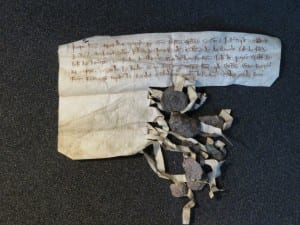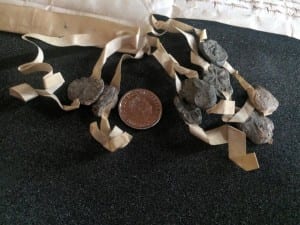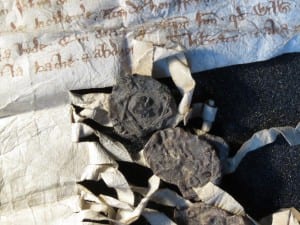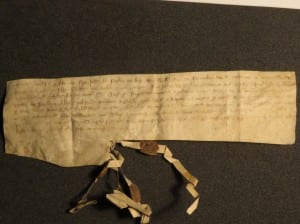
Hereford Cathedral Archives (HCA): No. 649
Of all the documents the team examined at Hereford Cathedral Archives, probably the most interesting personally were also the most unassuming. Hereford possesses a small set of jury verdicts dating from the early 14th century. These are pretty much as they sound, a written record of a jury’s verdict, in these instances relating to criminal trials. Most importantly for the project, the jurors each attached their seals as authentication of the verdict. While the amount of surviving judicial material in England is not insignificant by the late 13th and early 14th centuries, surviving verdicts with seals are comparatively very rare.
The verdicts are written on very small bits of parchment. Strips (known as tongues) were cut horizontally into the parchment at the bottom and the seals were attached on these, often with several seals to each tongue. The names of the jurors themselves are usually listed in the verdict, though we currently cannot match seals to names. Below are the contents of the verdict. Many of the seal impressions are now obliterated, but the ones which do survive are varied, and some are quite sophisticated in their design. What is particularly striking about these, however, is the tiny size of the seals (see the photo below for a comparison with a 5p coin).

HCA : No. 648
Tuesday next after the Feast of St. Hilary.
Verdict of a jury in the court of Madely, consisting of Phillip Dypre, Hugh de Karewardin, John de Kinleye, William de Godeweye, Walter de Cobliton’, Adam de Murmal, Roger de la Hyde, Walter son of Richard de Lolham, Richard de Abbrugge, Gilbert de Bellemere, Roger de Lolham, Robert de la Hull’, to the effect that Hugh son of William de la Bache is a thief and broke into the house of Hugh the smith of Madely and the house of Walter the smith of the same and stole flour and horseshoes and other goods, and the house of Margery de la Bache and stole woollen cloth and other goods.
Interestingly, the small size of Hereford’s surviving jury seals are also repeated in another type of criminal document dating from 1346. This is a receipt from four men to the sheriff of Hereford for assuming from the sheriff the responsibility of guarding a murder suspect until to his court appearance (see below, HCA 1116).
These are the smallest seals that the project has come across to date and, despite the fragmentary condition of some of them, they show a marked similarity in size. This in itself is intriguing. Is this related to the social status of the seal owners? Are they perhaps related by a common place or person of manufacture? Or are these seals perhaps peculiar to certain forms of documents, particularly those relating to criminal justice? If the latter, does it extend beyond Herefordshire? These are all questions which we will be exploring further.
Fergus PW Oakes

